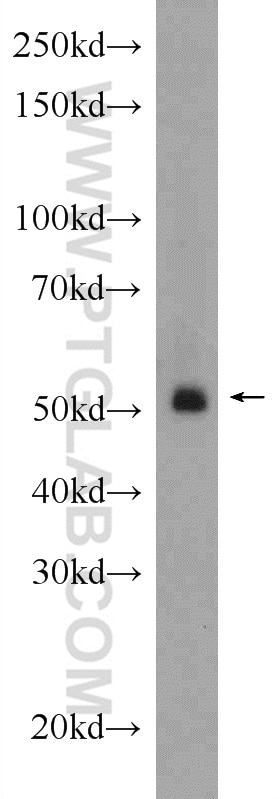- Phare
- Validé par KD/KO
Anticorps Polyclonal de lapin anti-BMPR2
BMPR2 Polyclonal Antibody for WB, IP, IHC, ELISA
Hôte / Isotype
Lapin / IgG
Réactivité testée
Humain, rat, souris
Applications
WB, IP, IF, IHC, ELISA
Conjugaison
Non conjugué
N° de cat : 19087-1-AP
Synonymes
Galerie de données de validation
Applications testées
| Résultats positifs en WB | tissu cardiaque humain, tissu cérébral de souris |
| Résultats positifs en IP | tissu cérébral de souris |
| Résultats positifs en IHC | tissu cardiaque humain, il est suggéré de démasquer l'antigène avec un tampon de TE buffer pH 9.0; (*) À défaut, 'le démasquage de l'antigène peut être 'effectué avec un tampon citrate pH 6,0. |
Dilution recommandée
| Application | Dilution |
|---|---|
| Western Blot (WB) | WB : 1:1000-1:6000 |
| Immunoprécipitation (IP) | IP : 0.5-4.0 ug for 1.0-3.0 mg of total protein lysate |
| Immunohistochimie (IHC) | IHC : 1:50-1:500 |
| It is recommended that this reagent should be titrated in each testing system to obtain optimal results. | |
| Sample-dependent, check data in validation data gallery | |
Applications publiées
| KD/KO | See 1 publications below |
| WB | See 5 publications below |
| IF | See 2 publications below |
Informations sur le produit
19087-1-AP cible BMPR2 dans les applications de WB, IP, IF, IHC, ELISA et montre une réactivité avec des échantillons Humain, rat, souris
| Réactivité | Humain, rat, souris |
| Réactivité citée | rat, Humain, souris |
| Hôte / Isotype | Lapin / IgG |
| Clonalité | Polyclonal |
| Type | Anticorps |
| Immunogène | BMPR2 Protéine recombinante Ag5868 |
| Nom complet | bone morphogenetic protein receptor, type II (serine/threonine kinase) |
| Masse moléculaire calculée | 115 kDa |
| Poids moléculaire observé | 120 kDa |
| Numéro d’acquisition GenBank | BC052985 |
| Symbole du gène | BMPR2 |
| Identification du gène (NCBI) | 659 |
| Conjugaison | Non conjugué |
| Forme | Liquide |
| Méthode de purification | Purification par affinité contre l'antigène |
| Tampon de stockage | PBS avec azoture de sodium à 0,02 % et glycérol à 50 % pH 7,3 |
| Conditions de stockage | Stocker à -20°C. Stable pendant un an après l'expédition. L'aliquotage n'est pas nécessaire pour le stockage à -20oC Les 20ul contiennent 0,1% de BSA. |
Informations générales
BMPs (bone morphogenetic protein) are involved in endochondral bone formation and embryogenesis. BMPR2 encodes a member of the (BMP) receptor family of transmembrane serine/threonine kinases. It is a widely expressed receptor, with high mRNA expression during development in many tissues. Dimer of BMPR2 receptors (70-80 kD) forms a complex with a dimer of type I BMPR1(50-55 kD) in signal transduction. This antibody recognizes endogenous levels of total BMPR2 protein, including 115 kD precursor, 75 kD mature form and 150 kD dimer.
Protocole
| Product Specific Protocols | |
|---|---|
| WB protocol for BMPR2 antibody 19087-1-AP | Download protocol |
| IHC protocol for BMPR2 antibody 19087-1-AP | Download protocol |
| IP protocol for BMPR2 antibody 19087-1-AP | Download protocol |
| FC protocol for BMPR2 antibody 19087-1-AP | Download protocol |
| Standard Protocols | |
|---|---|
| Click here to view our Standard Protocols |
Publications
| Species | Application | Title |
|---|---|---|
Theranostics Polycomb repressive complex 1 modulates granulosa cell proliferation in early folliculogenesis to support female reproduction | ||
Basic Res Cardiol The miR-182/Myadm axis regulates hypoxia-induced pulmonary hypertension by balancing the BMP- and TGF-β-signalling pathways in an SMC/EC-crosstalk-associated manner | ||
J Cell Biol A PINCH-1-Smurf1 signaling axis mediates mechano-regulation of BMPR2 and stem cell differentiation. | ||
Sci Signal Augmented noncanonical BMP type II receptor signaling mediates the synaptic abnormality of fragile X syndrome. | ||
Am J Physiol Lung Cell Mol Physiol Transforming growth factor-β plays divergent roles in modulating vascular remodeling, inflammation, and pulmonary fibrosis in a murine model of scleroderma | ||
Commun Biol Bone morphogenetic protein signaling is required for RAD51-mediated maintenance of genome integrity in vascular endothelial cells.
|



